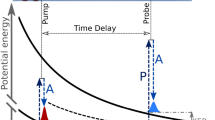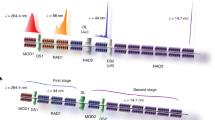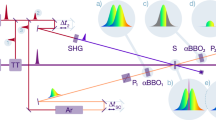Abstract
WE have adapted the method of delayed coincidences1 to the investigation of lifetimes of excited states of atomic helium. Helium gas at a pressure of about 0.01 mm. mercury was excited by a beam of 40 eV. electrons, and the photons emitted in the subsequent de-excitation detected by means of an E.M.I. VX 5031 photo-multiplier, the wave-lengths corresponding to the various transitions being selected by means of Barr and Stroud interference filters. The intensity of the electron beam was modulated by means of a grid which was maintained at a potential sufficiently negative to cut off the beam completely except during the application of a positive voltage pulse of duration 2 × 10−8 sec. and repetition rate 10 kc./s. The helium atoms were therefore excited by short bursts of electrons. The voltage pulses from the photomultiplier, corresponding to the ejection of single electrons from its cathode, were amplified and applied to one side of a coincidence unit of resolving time 2 × 10−8 sec. The pulse used for modulating the electron beam was also applied to the other side of the coincidence unit through a variable length of ‘Uniradio 57’ cable. A coincidence was therefore registered only if the delay in this cable was equal to the interval between the electron burst and the subsequent emission of a photon, and for delays longer than the overall resolving time of the apparatus the variation of coincidence-rate with delay should show an exponential decrease, the decay constant being the reciprocal of the mean life of the excited state involved. We are satisfied that for the transitions referred to below, the conditions of our experiment are such that the effects on the apparent lifetime of recombination of ions and of cascade transitions from higher states are negligible.
This is a preview of subscription content, access via your institution
Access options
Subscribe to this journal
Receive 51 print issues and online access
$199.00 per year
only $3.90 per issue
Buy this article
- Purchase on Springer Link
- Instant access to full article PDF
Prices may be subject to local taxes which are calculated during checkout
Similar content being viewed by others
References
See, for example, Bell, R. E., Graham, R. L., and Petch, H. E., Can. J. Phys., 30, 35 (1952).
Mitchell, A. C. G., and Zemansky, M. W., “Resonance Radiation and Excited Atoms”, 106 (Cambridge. 1934).
Holstein, T., Phys. Rev., 83, 1159 (1951).
Lees, J. H., and Skinner, H. W. B., Proc. Roy. Soc., A, 137, 186 (1932).
Hylleraas, E. A., Z. Phys., 106, 395 (1937).
Goldberg, L., Astrophys. J., 90, 414 (1939).
Bates, D. R., and Damgaard, A., Phil. Trans. Roy. Soc., A, 242, 101 (1950).
Author information
Authors and Affiliations
Rights and permissions
About this article
Cite this article
HERON, S., McWHIRTER, R. & RHODERICK, E. Measurements of Lifetimes of Excited States of Atoms by the Method of Delayed Coincidences. Nature 174, 564–565 (1954). https://doi.org/10.1038/174564a0
Issue Date:
DOI: https://doi.org/10.1038/174564a0
This article is cited by
-
XeI and XeII radiative lifetimes and transition probabilities
Soviet Physics Journal (1971)
-
Die Lebensdauer der Heliumzustände
Acta Physica Academiae Scientiarum Hungaricae (1966)
-
Decay curve of excited atomic levels and the beat of light
Il Nuovo Cimento B Series 10 (1965)
-
Application of Nuclear Coincidence Methods to Atomic Transitions in the Wave-length Range λλ 2000-6000 A.
Nature (1955)
Comments
By submitting a comment you agree to abide by our Terms and Community Guidelines. If you find something abusive or that does not comply with our terms or guidelines please flag it as inappropriate.



